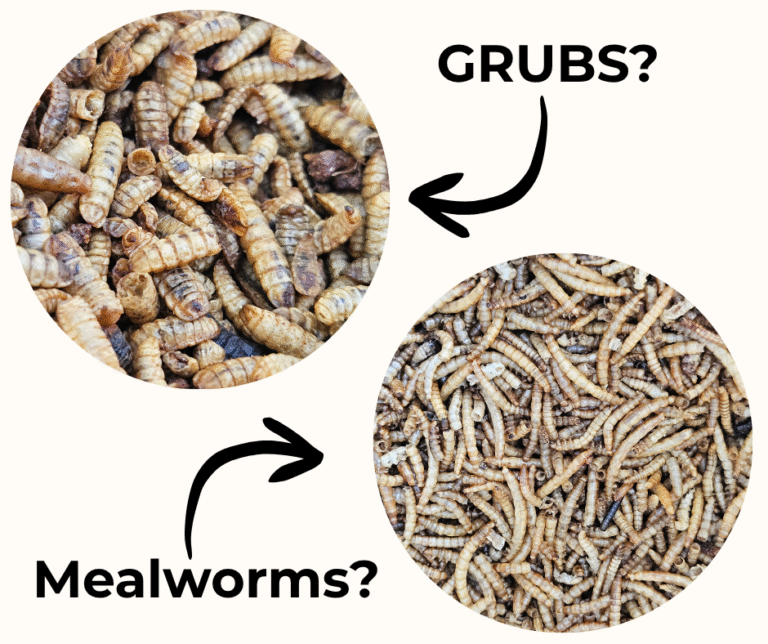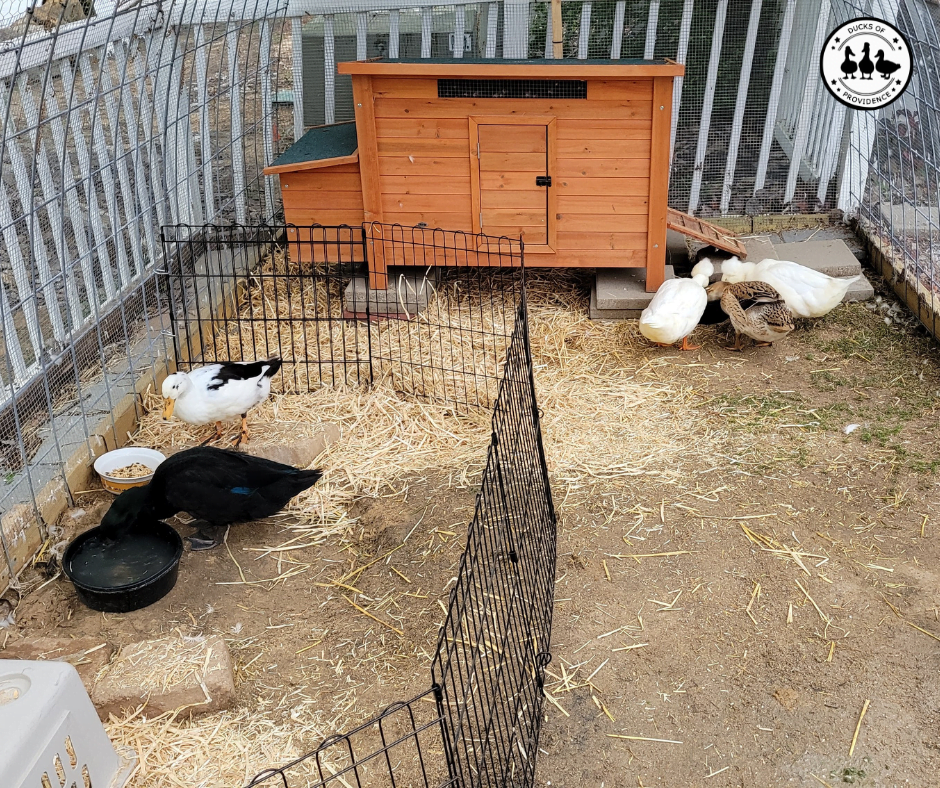
Introducing New Ducks: How to Expand Your Flock Without Drama
Last updated on November 26th, 2024 at 03:59 pm
Introducing new ducks to your flock is an exciting but delicate process. Whether you’re expanding your flock or adding a companion for a lonely duck, careful planning can help prevent stress and conflict. A well-executed introduction ensures that your ducks will live harmoniously, enjoying their time together in their new, expanded group.
- Choosing New Ducks: Factors to Consider
- The Importance of Quarantine
- Preparing the Flock: Setting the Stage for a Smooth Introduction
- The Introduction Process: Step-by-Step Guide to a Smooth Integration
- Black Soldier Fly Larvae
- Managing Flock Dynamics: Ensuring Harmony and Reducing Conflict
- Common Challenges and Solutions: Navigating the Hurdles of Flock Integration
- Final Thoughts: Fostering Harmony and Building a Strong Flock
- Other Posts you may enjoy:
Disclaimer: I may earn a commission if you buy products or services through my affiliate links. This will not affect the price you pay. I only recommend products or services that I believe will be beneficial to my readers.
Choosing New Ducks: Factors to Consider
Bringing new ducks into your flock is an exciting opportunity to diversify and enhance your group. However, careful consideration is necessary to ensure that the new additions will integrate smoothly with your existing ducks. Here’s a comprehensive guide on what to consider when choosing new ducks:
1. Breed Compatibility
Different duck breeds have varying temperaments, sizes, and needs. It’s important to choose breeds that will complement your current flock:
- Temperament: Some duck breeds are more docile, like Pekins or Buff Orpingtons, while others, like Khaki Campbells, can be more energetic or assertive. If your existing ducks are generally calm, introducing a more assertive breed could disrupt the harmony. It’s wise to research the temperament of the breed you’re considering to ensure it will mesh well with your flock’s dynamics.
- Size: Ducks of similar size are less likely to have conflicts. For example, a large breed like a Muscovy might unintentionally bully smaller breeds like Call ducks or Australian Spotteds due to their size difference. Aim to choose ducks that are close in size to your current flock to reduce potential issues.
- Purpose: Consider the purpose of your flock. If you’re raising ducks primarily for eggs, you might want to add prolific layers like Khaki Campbells or Indian Runners. If you’re interested in meat production, breeds like Pekins or Aylesburys might be more suitable. If your focus is on ornamental ducks, choose breeds known for their striking plumage, like Welsh Harlequins or Silver Appleyards.
2. Age Considerations
The age of the new ducks is another critical factor:
- Ducklings vs. Adults: Introducing ducklings can be easier in terms of integration, as they are less likely to challenge the established pecking order. However, they require more care and protection during their early weeks. Adult ducks, on the other hand, are more self-sufficient but may assert themselves more aggressively when introduced to a new flock.
- Breeding Age: If you’re looking to expand your flock for breeding purposes, consider the age and breeding viability of the new ducks. Younger ducks in their first or second year are typically more fertile and have higher reproductive potential.
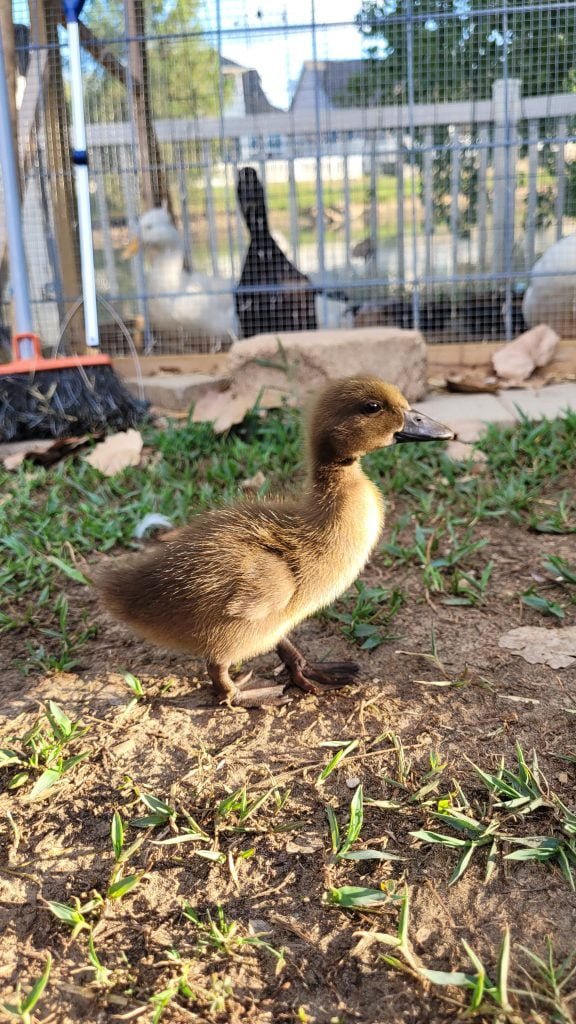
3. Health Status
The health of the new ducks is paramount. Before purchasing or adopting, check for the following:
- Physical Condition: Inspect the ducks for any signs of illness or physical deformities. Their eyes should be clear and bright, nostrils free from discharge, and feathers smooth and clean. Look for signs of external parasites like mites or lice, which could spread to your flock.
- Behavior: Healthy ducks are usually active, alert, and have good appetites. Watch for any signs of lethargy, limping, or unusual behavior, which could indicate underlying health issues.
- Source of Purchase: Buy ducks from reputable breeders or farms that practice good biosecurity measures. If possible, visit the breeder’s location to see the conditions in which the ducks are raised. Avoid buying from sources where ducks are overcrowded, dirty, or showing signs of stress.
➡️ Learn how to conduct a duck health check.
4. Gender Balance
Balancing the ratio of males to females in your flock is crucial to maintaining peace:
- Male to Female Ratio: A common recommendation is one drake (male duck) to three to five ducks (females). Too many drakes can lead to aggressive behavior and over-mating, which can stress and injure the female ducks. If you’re adding new drakes, consider whether your current flock has enough females to maintain a healthy balance.
- Single-Sex Flock: If you prefer not to deal with breeding, consider maintaining a single-sex flock. Female-only flocks focus on egg production without the complications of mating behaviors. Conversely, a drake-only flock can also work but may require more space and careful management to prevent fighting.
➡️ Read more about this topic in our post Pet Ducks: How Many Should I Have? And where do I get them from?
5. Consideration of Existing Flock Dynamics
Understanding the dynamics of your current flock can help you make better choices when adding new ducks:
- Pecking Order: Every flock has a social hierarchy. Introducing new ducks can disrupt this pecking order, leading to conflicts. It’s often easier to introduce ducks of similar age and temperament, as they are less likely to challenge the established hierarchy.
- Group Size: If your flock is small, adding a larger group of new ducks might overwhelm the existing members. Conversely, adding just one or two ducks to a larger flock can make the newcomers more vulnerable to bullying. Try to balance the numbers so that no group is significantly outnumbered.
6. Special Needs and Requirements
Some duck breeds or individual ducks may have special needs that should be considered:
- Dietary Needs: Certain breeds may have specific dietary requirements. For example, some ornamental ducks may need a more specialized diet to maintain their vibrant plumage, while larger meat breeds may require more protein-rich feed.
- Environmental Requirements: Some ducks, like Muscovies, prefer more perching areas and tree cover, whereas others might thrive better in open water spaces. Consider the environment you can provide when choosing new ducks.
- Special Care: If you’re adding ducks with known health issues or disabilities, be prepared for the extra care they may require. This could include more frequent health checks, specialized housing, or tailored diets.
➡️ Read more about the nutritional needs of ducks.
Final Considerations
Adding new ducks to your flock can bring fresh energy and diversity, but it requires careful thought. By considering breed compatibility, age, health, gender balance, existing flock dynamics, and any special needs, you can choose ducks that will integrate well and contribute positively to your flock. Remember, a well-chosen addition can enhance the harmony and happiness of your entire flock.
The Importance of Quarantine
Before introducing new ducks to your existing flock, it’s critical to implement a quarantine period. This step is often overlooked but can be a game-changer in maintaining the health and harmony of your entire flock. Here’s why quarantine is essential and how to go about it:
1. Why Quarantine Matters
Quarantine is the process of keeping new ducks separate from your existing flock for a set period—typically 30 days. This separation serves several vital purposes:
- Preventing Disease Spread: Ducks can carry diseases or parasites that may not be immediately visible. These can range from respiratory infections and fungal issues to external parasites like mites or lice. A quarantine period allows time for any latent illnesses to manifest, ensuring they don’t spread to your entire flock.
- Monitoring Health: Quarantine gives you a chance to closely observe the new ducks for signs of illness. Look for symptoms such as lethargy, sneezing, coughing, unusual droppings, or changes in appetite. Regularly check their feathers, eyes, and nostrils for any abnormalities.
- Stress Management: Moving to a new environment can be stressful for ducks, which may weaken their immune system temporarily. Quarantine helps reduce stress by allowing them to acclimate to their new surroundings gradually, without the added pressure of integrating with the existing flock immediately.
➡️ Learn How to Conduct a Duck Health Check: A Comprehensive Guide.
2. Setting Up a Quarantine Area
To effectively quarantine your new ducks, you’ll need a separate space that’s well away from your existing flock. Here are some key considerations:
- Location: The quarantine area should be at least 30 feet away from your main flock to prevent any airborne diseases from spreading. If possible, house them in a completely different area of your property.
- Housing Setup: Ensure the quarantine space is secure, with adequate shelter, food, and water. It should mimic the living conditions of your main flock as much as possible to reduce stress. Providing plenty of bedding and keeping the area clean will also help the ducks settle in.
- Biosecurity Measures: Practice strict biosecurity during the quarantine period. This includes washing your hands before and after handling the new ducks, using separate tools and equipment, and possibly even wearing different shoes or clothing when tending to the quarantine area. This minimizes the risk of transferring pathogens between the two groups.
- Observation and Care: During the quarantine period, observe your new ducks closely. Regularly check their weight, observe their behavior, and monitor their droppings for any signs of illness. If you notice anything concerning, consult with a veterinarian before proceeding with the introduction.

3. After the Quarantine Period
Once the 30-day quarantine period is over, and your new ducks show no signs of illness, they can begin the introduction process with your existing flock. However, even after quarantine, monitor them closely during the initial integration phase to ensure they adjust well and remain healthy.
By implementing a thorough quarantine process, you protect your new and existing ducks, setting the stage for a successful and harmonious flock expansion.
Before introducing your new ducks to the flock, a quarantine period of at least 30 days is crucial. This helps prevent the spread of potential diseases or parasites that the new ducks might carry. During this time, you can observe their health and start getting them accustomed to their new environment.
Preparing the Flock: Setting the Stage for a Smooth Introduction
Before introducing new ducks to your existing flock, it’s important to ensure that your current ducks are ready to accept new members. Proper preparation can minimize stress, reduce the chances of aggression, and create a more harmonious environment for your existing and new ducks. Here’s how to prepare your flock for the arrival of new members:
1. Assessing the Health and Well-Being of Your Existing Flock
The health and well-being of your existing ducks should be your top priority before introducing new members:
- Health Check: Perform a thorough health check on your current flock to ensure they’re free from illness, parasites, or any underlying health issues. Healthy ducks are less likely to be stressed by the introduction of new members and can better handle any potential disruptions to their routines.
- Vaccinations and Treatments: Ensure that your existing ducks are up-to-date on any necessary vaccinations or treatments, such as worming. This reduces the risk of disease transmission and keeps your flock robust.
- Stress Levels: Assess the overall stress levels of your flock. Ducks that are already stressed due to environmental factors, predator threats, or recent changes (like a move or a loss) may not handle the introduction of new ducks well. If your flock seems stressed, consider delaying the introduction until they’re more settled.
2. Setting Up a Separate Introduction Area
Creating a designated introduction area is crucial for allowing your ducks to get used to each other gradually:
- Visual and Auditory Introduction: The introduction area should allow the new ducks to see and hear the existing flock without direct physical contact. This setup allows both groups to become familiar with each other’s presence without the immediate pressure of interacting. A fenced or mesh divider works well for this purpose, enabling the ducks to observe each other and assess body language without the risk of aggression.
- Neutral Territory: If possible, use a neutral space that doesn’t belong to the existing flock. This can be an area they don’t regularly use or a section of their enclosure that’s been temporarily closed off. Introducing the ducks in a neutral space helps prevent territorial behavior, which can lead to conflicts.
- Comfort and Resources: Ensure the introduction area is comfortable and well-equipped with food, water, and shelter. Providing ample resources helps reduce competition and makes the new ducks feel more at ease.

3. Preparing Your Existing Ducks for the Newcomers
Helping your existing flock adjust to the idea of new members can ease the transition:
- Gradual Exposure: Start by allowing your existing ducks to become aware of the new ducks’ presence through sight and sound, but without direct interaction. This can be done by placing the new ducks in a nearby enclosure or run where the existing ducks can observe them safely. Over time, your ducks will become more accustomed to the newcomers, reducing the likelihood of aggressive behavior when they’re eventually introduced.
- Enrichment and Distraction: Provide extra enrichment for your existing flock during the introduction process. This could include new toys, additional foraging opportunities, or new water features. Keeping your ducks occupied with positive activities can reduce the chances of stress and aggression when new ducks are introduced.
- Rearranging the Enclosure: Consider rearranging the existing flock’s enclosure or adding new elements, such as perches, hiding spots, or additional feeders. This can help break up any established territorial boundaries and make the introduction of new ducks feel less like an intrusion.
4. Ensuring Adequate Space and Resources
Space and resource availability are key factors in a successful introduction:
- Space Requirements: Ducks need plenty of space to move around, forage, and establish their social hierarchy. Overcrowding can lead to stress, competition, and aggression. Before introducing new ducks, ensure that your existing enclosure has enough space to comfortably accommodate the expanded flock. As a general rule, provide at least 4 square feet per duck in the coop and 10 square feet per duck in the outdoor run.
- Additional Resources: Prepare to increase the number of food and water stations to reduce competition. When resources are plentiful, ducks are less likely to fight or bully each other. Placing feeders and waterers in multiple locations also prevents any one duck from monopolizing these essential resources.
- Shelter and Nesting Areas: Ensure there are enough shelter and nesting areas for the expanded flock. Ducks need safe spaces to retreat to, especially during the initial introduction phase when the pecking order is being established. Providing extra nesting boxes or cozy corners can help reduce stress and give the new ducks a place to feel secure.
➡️ Need inspiration for duck runs? Read our DIY Hoop Coop Guide.

5. Monitoring Behavior and Preparing for Intervention
Even with careful preparation, it’s important to be ready to step in if things don’t go as planned:
- Observation: During the introduction period, closely monitor the behavior of both the existing flock and the new ducks. Look for signs of acceptance, such as curiosity, mutual preening, or simply ignoring each other. At the same time, watch for any signs of aggression, such as chasing, pecking, or bullying.
- Intervention Plans: If you notice aggressive behavior, be prepared to intervene. This might mean separating the ducks temporarily or giving the aggressor a “time out” by placing them in a separate area for a short period. Sometimes, reintroducing the ducks more gradually or altering the introduction environment can help.
- Gradual Integration: Remember, introducing new ducks is a process, not a one-time event. If the ducks don’t seem to be getting along right away, take a step back and slow down the process. Sometimes, giving them more time to adjust to each other’s presence is all that’s needed for a smooth integration.
Final Thoughts on Preparing the Flock
Properly preparing your existing flock for the arrival of new ducks is key to a successful and stress-free introduction. By ensuring your current ducks are healthy, setting up a thoughtful introduction area, providing ample space and resources, and being ready to monitor and intervene, you can create a welcoming environment where both old and new ducks can thrive together.
The Introduction Process: Step-by-Step Guide to a Smooth Integration
Introducing new ducks to your existing flock is a delicate process that requires patience, careful planning, and observation. By following a step-by-step approach, you can help ensure a smooth and stress-free integration for both the newcomers and your current ducks. Here’s a comprehensive guide to the introduction process:
1. Start with a Visual Introduction
The first step in introducing new ducks is to allow them to see and hear each other without direct contact. This initial phase helps both groups get accustomed to one another’s presence without the risk of immediate confrontation.
- Separate Enclosures: Place the new ducks in a separate but adjacent enclosure where they can see and interact with the existing flock through a fence or mesh barrier. This setup allows them to observe each other’s behavior and establish a sense of familiarity while still maintaining a physical barrier to prevent any aggressive encounters.
- Duration: Keep the ducks in this setup for at least a few days to a week, depending on how they respond. Observe their interactions closely—look for signs of curiosity or calmness, as well as any aggressive behavior like lunging or aggressive vocalizations. The goal is to allow the ducks to grow comfortable with each other’s presence before moving on to the next step.
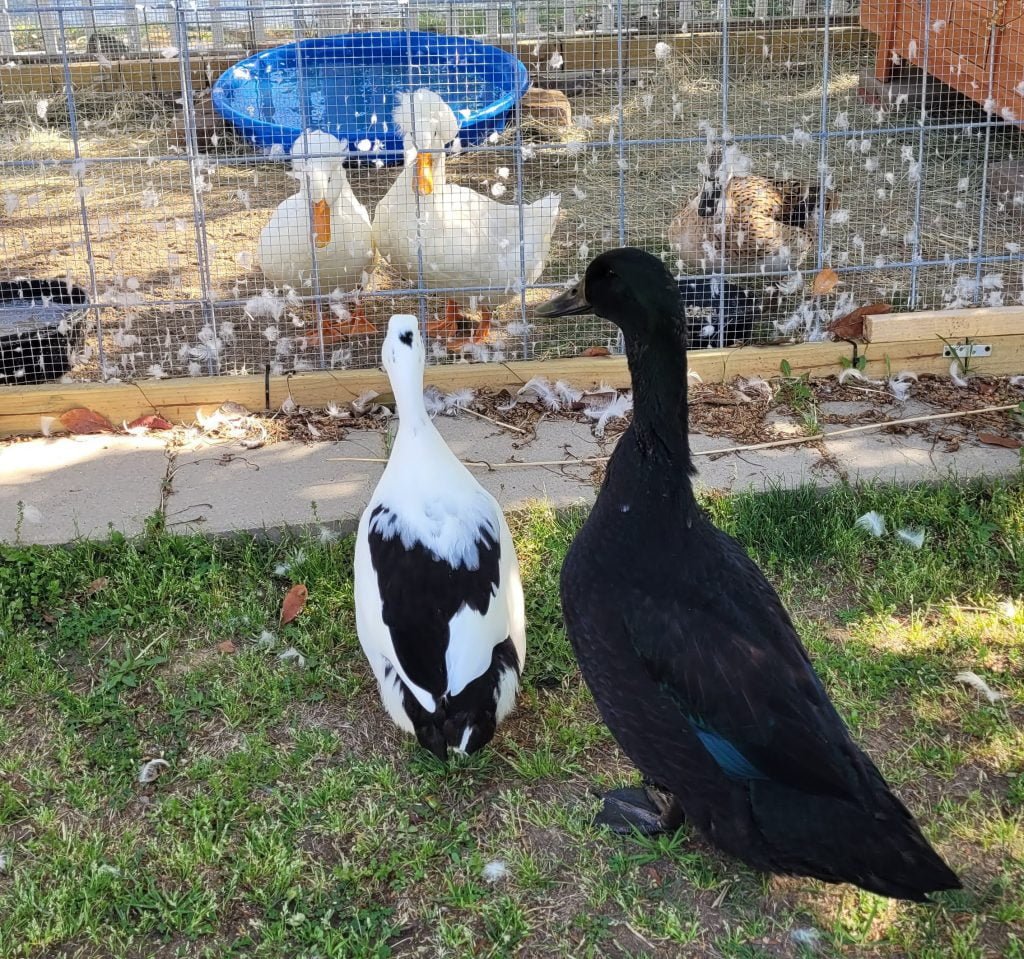
2. Controlled Physical Introduction
Once the ducks have had time to get used to each other visually, it’s time to move on to a more direct but controlled introduction. This stage allows the ducks to interact physically under close supervision.
- Neutral Territory: If possible, conduct the first physical introduction in a neutral area where neither group feels territorial. This could be a section of the yard or a new part of the enclosure that both groups are unfamiliar with. Introducing them in a neutral space can help minimize territorial aggression.
- Supervised Interaction: Allow the ducks to interact for short periods, starting with just a few minutes and gradually increasing the time as they become more comfortable. Stay close by during these initial meetings to intervene if any aggressive behavior occurs. If the ducks begin to chase, peck, or show other signs of aggression, calmly separate them and try again later.
- Use Distractions: Providing distractions during the introduction can help diffuse tension. Scatter some treats or add a new toy or foraging activity to keep the ducks occupied. This can redirect their attention away from each other and toward positive, shared experiences.

Black Soldier Fly Larvae
Treats are an excellent way to bond with new flock members, and grubs, specifically BSL (black soldier fly larvae), are perfect for the job. Packed with proteins, fats, and a calcium content far higher than mealworms, they’re a natural powerhouse for your ducks. These treats support optimal health and vibrant plumage, ensuring your feathered friends thrive. Plus, we’re thrilled to offer an exclusive discount on Grub Terra products! Use code Providence10 to save 10% on your first order, valid on all their products.
3. Gradual Integration
After the initial controlled introductions, the next step is to gradually integrate the new ducks into the main flock. This phase requires patience, as rushing the process can lead to unnecessary stress and conflict.
- Extend Interaction Time: Gradually increase the amount of time the new ducks spend with the existing flock each day. Monitor their behavior closely during these extended interactions. If they seem to be getting along well, you can start leaving them together for longer periods, including supervised free-range time or shared access to the pond or other favorite flock areas.
- Watch for Signs of Acceptance: Acceptance in a flock is usually indicated by the ducks showing calm and relaxed behavior around each other. Look for signs like shared preening, foraging together, or simply ignoring each other as they go about their business. These behaviors suggest that the ducks are beginning to accept the new members as part of their group.
- Addressing Pecking Order: Ducks naturally establish a pecking order, which can sometimes involve minor pecking or chasing. This behavior is normal as long as it doesn’t escalate into severe aggression or injury. Allow the ducks to work out their hierarchy, but step in if any ducks are being overly bullied or if there’s a risk of harm.
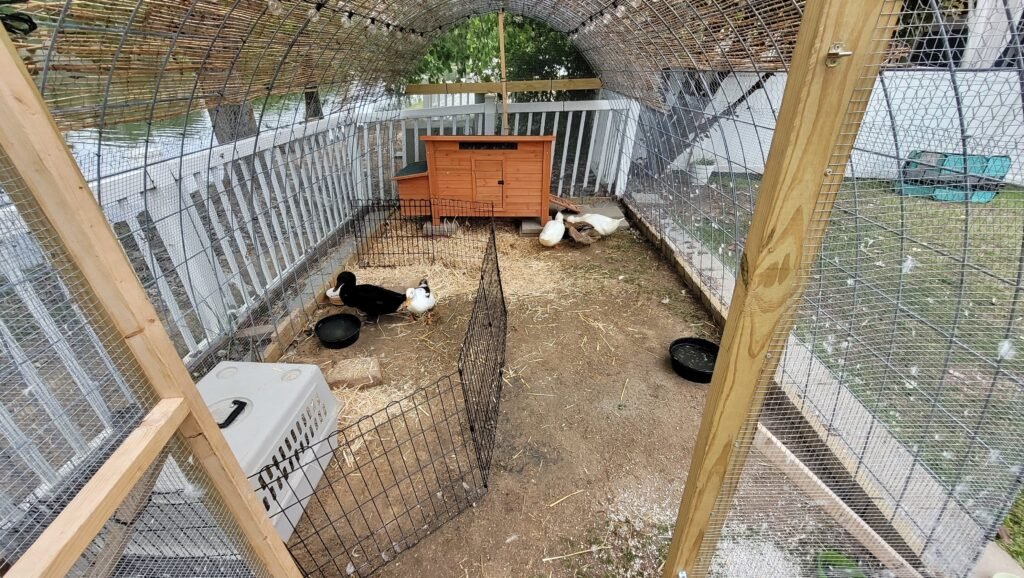
4. Full Integration
Once the ducks are comfortable spending extended periods together without significant issues, you can move toward full integration. This is when the new ducks become permanent members of the flock.
- Shared Sleeping Arrangements: Start allowing the new ducks to sleep in the same coop or shelter as the existing flock. It’s best to do this after a day of supervised interaction when the ducks are more likely to be tired and less inclined to fight. Ensure there’s enough space, bedding, and nesting areas for all ducks to feel secure. (Need a new house? ➡️ Check out our super easy DIY duck house)
- Final Monitoring: Even after full integration, continue to monitor the flock closely for the next few weeks. It’s important to ensure that the new ducks have truly been accepted and that any minor conflicts are resolving themselves. If you notice ongoing tension, consider reintroducing the steps for gradual integration or providing additional resources like feeders and shelters to reduce competition.
- Be Patient: Full integration can take anywhere from a few days to several weeks, depending on the ducks’ personalities and the existing flock dynamics. Patience is key—allow the process to unfold naturally, and don’t rush the ducks into accepting each other faster than they’re ready.
Pro Tip: When integrating new ducks into your flock, consider using foldable metal playpens to create temporary separations. These pens allow the ducks to see and interact with each other safely, reducing stress and making the transition smoother.
5. Dealing with Challenges
Sometimes, despite your best efforts, challenges can arise during the introduction process. Knowing how to address these issues is crucial for maintaining harmony in your flock.
- Aggression: If aggression persists, try separating the ducks again and restarting the introduction process more slowly. In some cases, introducing the new ducks one at a time or in pairs can be less threatening to the existing flock.
- Bullied Ducks: If one or more of the new ducks are being consistently bullied, provide them with safe spaces to retreat to, such as extra hiding spots or separate feeding areas. You might also consider adding another duck to the new group to create a more balanced dynamic.
- Behavioral Issues: Sometimes, ducks may exhibit unusual behaviors during the introduction, such as excessive quacking, refusal to eat, or staying away from the flock. These can be signs of stress. Ensure they have plenty of space, access to food and water, and minimal disturbances to help them adjust.
Final Thoughts on the Introduction Process
The introduction of new ducks to an existing flock is a process that requires careful planning, observation, and patience. By starting with a visual introduction, moving to controlled interactions, and gradually integrating the ducks into the flock, you can help ensure a smooth and successful transition. Remember, every flock is different, and what works for one group may need to be adjusted for another. With time and care, your new and old ducks will find their place in the pecking order and live together harmoniously.
Managing Flock Dynamics: Ensuring Harmony and Reducing Conflict
Once new ducks have been integrated into your flock, it’s important to actively manage flock dynamics to ensure ongoing harmony. Ducks, like all animals, have social hierarchies, and managing these dynamics effectively can prevent conflicts, reduce stress, and create a peaceful environment for your birds. Here’s how to maintain a balanced and happy flock:
1. Understanding the Pecking Order
The pecking order is the natural hierarchy that ducks establish within a flock. It determines access to resources like food, water, and preferred nesting spots, as well as the overall social structure.
- Establishment of Hierarchy: When new ducks are introduced, the pecking order is likely to shift as the flock integrates the new members. This is a normal part of duck behavior and can involve some chasing, pecking, and squabbling as the ducks figure out their new roles. While this process is usually harmless, it’s important to monitor it to ensure it doesn’t escalate into harmful aggression.
- Signs of Healthy Pecking Order: In a well-established pecking order, you’ll notice that most conflicts are brief and non-violent. The ducks will settle into their roles, with dominant birds taking the lead and others following suit. Over time, the flock will operate smoothly with minimal disruptions.
- When to Intervene: If one or more ducks are consistently being bullied, excluded from resources, or injured, it may be necessary to intervene. This could involve separating the aggressive ducks temporarily, providing additional resources to reduce competition, or rearranging the environment to break up established territories.
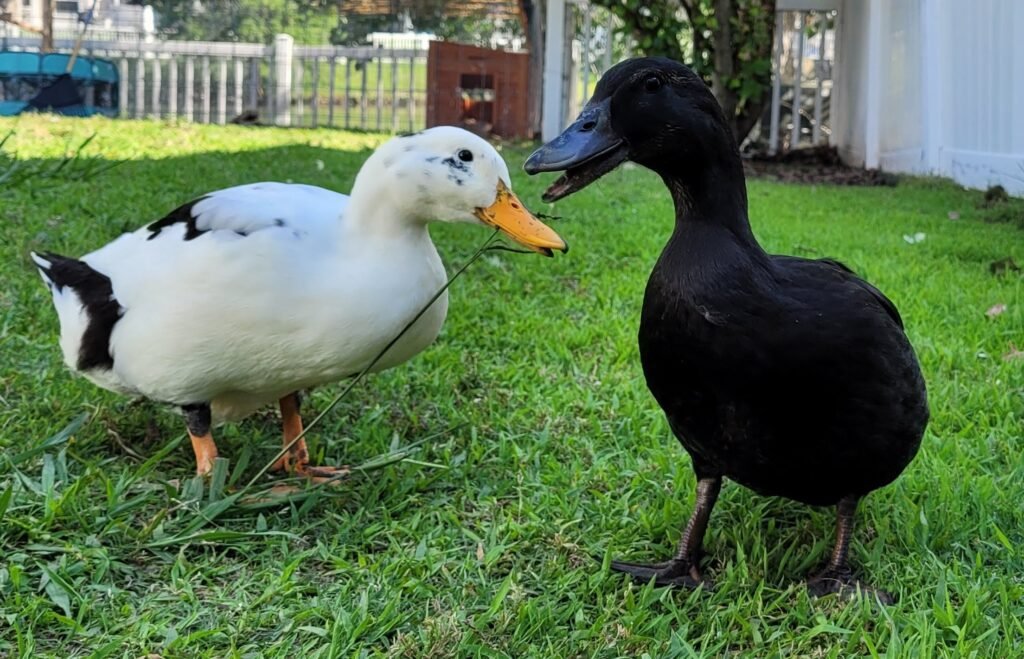
2. Ensuring Adequate Resources
Competition for resources is a common cause of conflict in duck flocks. Ensuring that all ducks have access to food, water, shelter, and nesting areas can help reduce tension and promote harmony.
- Multiple Feeding Stations: To prevent dominant ducks from monopolizing food, set up multiple feeding stations throughout the enclosure. This allows all ducks, especially the more submissive ones, to eat without being harassed. Distribute these stations in different locations to reduce the chances of one duck guarding all the resources.
- Water Access: Ducks need constant access to clean water for drinking and preening. Ensure that there are multiple water sources available, particularly if you have a large flock. If possible, provide water stations at different heights or locations to accommodate ducks with different preferences.
- Shelter and Nesting Areas: Ducks need safe spaces to rest and lay eggs. Ensure that there are enough nesting areas for all the ducks, with extra spots for any newcomers who may not yet have established their place in the flock. Providing sheltered areas where ducks can retreat can also help reduce stress.
- Space Considerations: Overcrowding can lead to stress and conflict. Make sure your enclosure provides enough space for the flock to move freely and establish their own territories. As a rule of thumb, provide at least 10 square feet of outdoor space per duck to minimize the risk of conflict.
3. Observing and Addressing Behavioral Changes
Ducks are generally calm and social animals, but changes in behavior can indicate issues within the flock dynamics. Regular observation can help you catch and address these issues early.
- Signs of Stress or Aggression: Look for signs of stress, such as excessive quacking, feather plucking, or changes in eating habits. Aggressive behaviors may include pecking, chasing, or preventing other ducks from accessing resources. If you notice any of these behaviors, it’s important to identify the cause and take steps to address it.
- Monitoring Health: Sometimes, behavioral changes can be a sign of underlying health issues. If a duck is consistently bullied or excluded, it may be because it’s unwell or weaker than the others. Conduct regular health checks to ensure that all ducks are in good condition and address any health concerns promptly.
- Encouraging Positive Interactions: Reinforce positive interactions within the flock by providing enrichment activities that encourage group foraging or play. This can include scattering treats in the enclosure for them to find together, providing a new water feature, or introducing toys like mirrors or floating objects in the water. These activities can help strengthen social bonds and reduce tension.
4. Handling Aggression
Occasional aggression is natural in duck flocks, but persistent or severe aggression needs to be managed to prevent injury and maintain flock harmony.
- Identify Aggressors: If one duck is particularly aggressive, identify the root cause. Aggression can stem from fear, stress, illness, or simply the duck’s position in the pecking order. Understanding the cause will help you determine the best course of action.
- Temporary Separation: In cases of severe aggression, consider temporarily separating the aggressive duck from the flock. This “time out” can help the aggressor cool down and give the rest of the flock a chance to settle without the threat of conflict. After a few days, reintroduce the duck gradually, starting with visual contact before allowing physical interaction.
- Environmental Adjustments: Sometimes, making changes to the environment can reduce aggression. This might include adding more hiding spots, rearranging the enclosure to disrupt established territories, or increasing the space available to the flock. These changes can help break up negative patterns of behavior and create a more peaceful environment.
- Introducing New Ducks to Aggressive Flocks: If you already have a flock known for its aggressive tendencies, be extra cautious when introducing new ducks. Take more time with the introduction process, use barriers to allow gradual integration, and be prepared to intervene quickly if conflicts arise. You may also want to introduce new ducks in pairs, as they can support each other and reduce the focus of aggression.
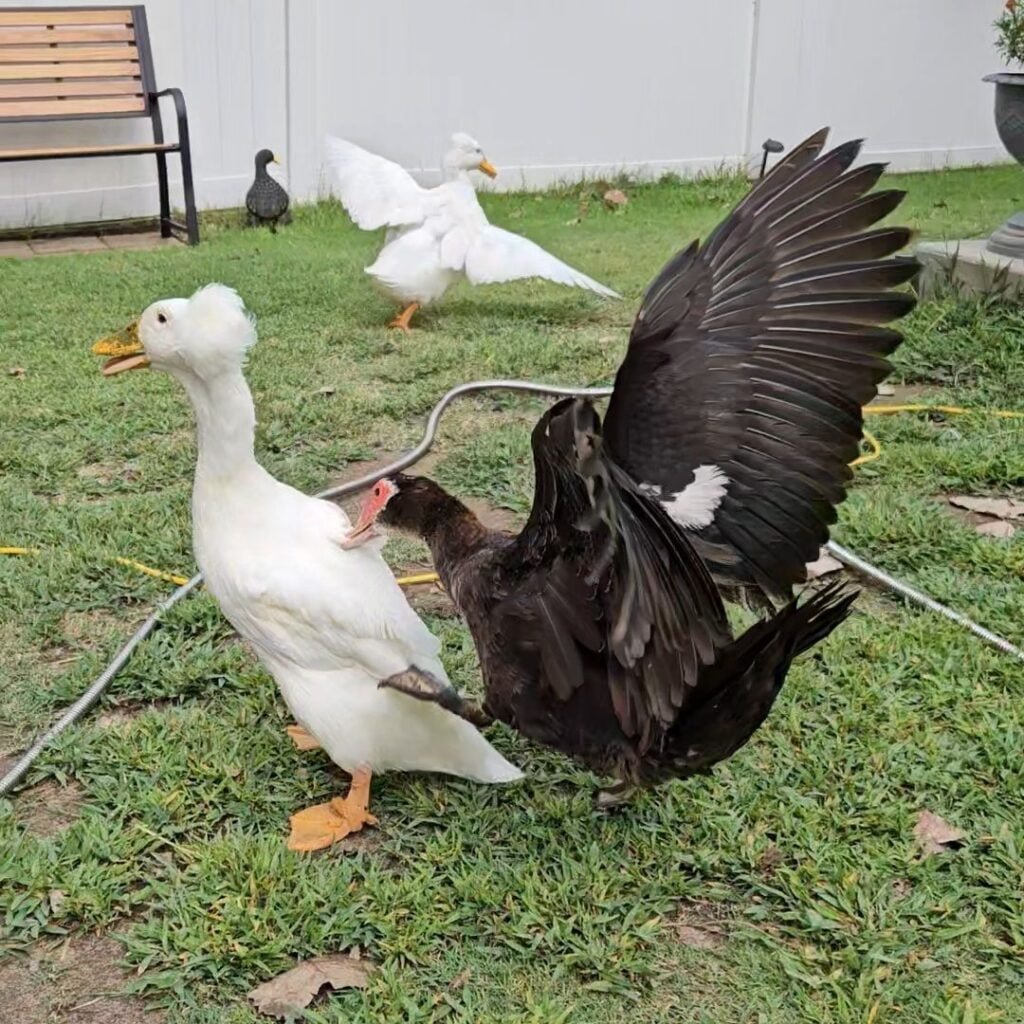
5. Long-Term Flock Management
Maintaining harmony in your flock is an ongoing process. Regular monitoring, adjustments, and understanding of duck behavior are key to ensuring long-term success.
- Routine Check-Ins: Make it a habit to regularly observe your flock’s behavior and dynamics. Early detection of any issues allows for quick intervention, preventing problems from escalating. This could be a daily or weekly check-in where you observe interactions, check for signs of stress or illness, and ensure that all ducks have access to resources.
- Seasonal Considerations: Flock dynamics can change with the seasons. For example, during breeding season, drakes (male ducks) may become more aggressive or protective. Be prepared to manage these seasonal changes by providing extra space, separating drakes if necessary, or adjusting resources to accommodate heightened needs.
- Ongoing Enrichment: Keep your ducks engaged and happy by regularly introducing new forms of enrichment. This could include rotating toys, changing the layout of their enclosure, adding new foraging opportunities, or simply giving them a different area to explore. Engaged ducks are less likely to engage in negative behaviors and more likely to form strong, positive bonds with their flockmates.
Final Thoughts on Managing Flock Dynamics
Successfully managing flock dynamics involves understanding the natural behavior of ducks, providing adequate resources, and being vigilant in observing and addressing any issues that arise. By fostering a balanced environment where all ducks can thrive, you’ll ensure that your flock remains happy, healthy, and harmonious. Remember, each flock is unique, and what works for one may need to be adjusted for another. Patience, consistency, and a keen eye for behavior will go a long way in maintaining peace within your flock.
Common Challenges and Solutions: Navigating the Hurdles of Flock Integration
Introducing new ducks to an existing flock can come with its own set of challenges. These challenges can range from minor behavioral issues to more significant conflicts, but with the right strategies, they can be effectively managed. Below are some common challenges you might encounter during the integration process, along with practical solutions to overcome them.
1. Aggression and Bullying
One of the most common challenges when introducing new ducks to a flock is aggression and bullying. Established ducks may see the newcomers as a threat to their resources or status in the pecking order, leading to aggressive behavior.
- Problem: Aggressive Pecking or Chasing
- Solution: To manage aggression, start by ensuring that the introduction process is gradual. Use visual barriers during the initial phase so the ducks can see but not touch each other. If aggression occurs during physical introductions, separate the ducks and try again later, perhaps in a neutral area where the older ducks don’t feel territorial. Providing distractions, such as scattering treats or introducing new toys, can also help to divert attention away from the new ducks and reduce aggressive behavior.
- Problem: Persistent Bullying
- Solution: If bullying continues despite gradual introduction, consider temporarily removing the bully from the flock. A few days of isolation can lower the bully’s status in the flock, making them less likely to be aggressive when reintroduced. Also, ensure that there are multiple feeders and water stations to reduce competition and give bullied ducks plenty of space to retreat to if needed.
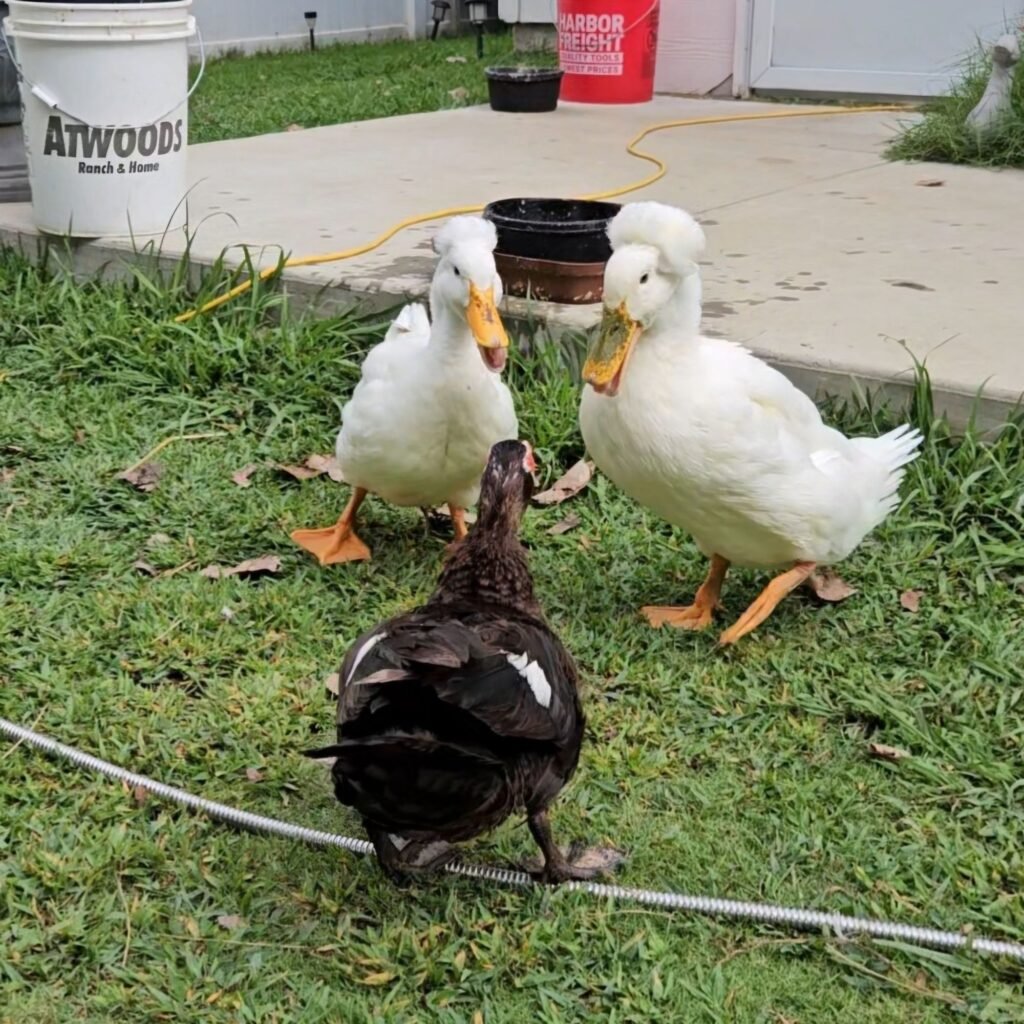
2. Health Concerns
Health issues can arise when new ducks are introduced to a flock, particularly if the new arrivals are carrying illnesses or parasites that can spread to the existing flock.
- Problem: Spread of Disease
- Solution: Quarantine new ducks for at least two weeks before introducing them to your flock. This period allows you to monitor the newcomers for any signs of illness, such as respiratory issues, lethargy, or unusual droppings. During quarantine, provide a separate water source, bedding, and feeding area to prevent cross-contamination. If any health concerns arise, consult a veterinarian before proceeding with the integration.
- Problem: Parasite Infestation
- Solution: Before introducing new ducks, treat them for common parasites like mites or lice. Even if they appear healthy, a preventative treatment can help ensure they don’t bring any unwanted pests into the flock. Additionally, consider using diatomaceous earth in nesting areas and regular dust baths to help keep parasites at bay.
3. Resource Competition
Competition for food, water, nesting spots, and even bathing areas can lead to tension within the flock, especially when new ducks are introduced.
- Problem: Limited Access to Food and Water
- Solution: Ensure that there are enough feeding and water stations to accommodate the entire flock. Spread these resources throughout the enclosure so that no single duck or group can dominate them. If necessary, create separate feeding zones for the new ducks until they are fully integrated and confident enough to compete with the older flock members.
- Problem: Nesting Space Conflicts
- Solution: Provide additional nesting areas to prevent competition. Ducks are territorial about their nesting spots, so ensuring that there are plenty of options can help reduce conflict. Place nests in quiet, secluded areas where ducks can feel secure. If the conflict persists, consider rearranging the nesting areas to disrupt established territories and encourage sharing.
4. Integrating Different Ages or Breeds
Introducing ducks of different ages or breeds can pose unique challenges, as ducks may not immediately recognize each other as part of the same flock.
- Problem: Older Ducks Rejecting Younger Ducks
- Solution: When introducing younger ducks, it’s essential to wait until they are of a similar size to the older ducks. This reduces the likelihood of them being bullied due to their smaller size. If necessary, introduce the young ducks in pairs or groups to give them strength in numbers. Monitor interactions closely and provide safe spaces where younger ducks can retreat if needed.
- Problem: Breed-Specific Behavior Differences
- Solution: Different duck breeds may have varying temperaments, which can affect how they integrate into a flock. For example, more docile breeds might be intimidated by more assertive breeds. Understanding the specific traits of each breed can help you anticipate and manage potential conflicts. Provide plenty of space and observe how different breeds interact, intervening if necessary to prevent bullying or stress.
5. Territorial Disputes
Territorial behavior is another common issue when integrating new ducks, especially if the existing flock has established strong bonds and defined spaces within the enclosure.
- Problem: Ducks Guarding Specific Areas
- Solution: Introducing new ducks in a neutral space can help reduce territorial disputes. If the existing ducks are particularly protective of certain areas, consider temporarily blocking off those spaces or reconfiguring the enclosure layout. This forces the flock to explore new areas together, breaking up established territories and encouraging a more inclusive dynamic.
- Problem: Aggression in Shared Spaces (e.g., Pool, Nesting Areas)
- Solution: Gradually increase the amount of time the new ducks spend in shared spaces, starting with short, supervised sessions. Ensure that there are multiple options for each resource, such as several nesting boxes or multiple pools. This reduces competition and allows the new ducks to find their place without being forced into confrontation.
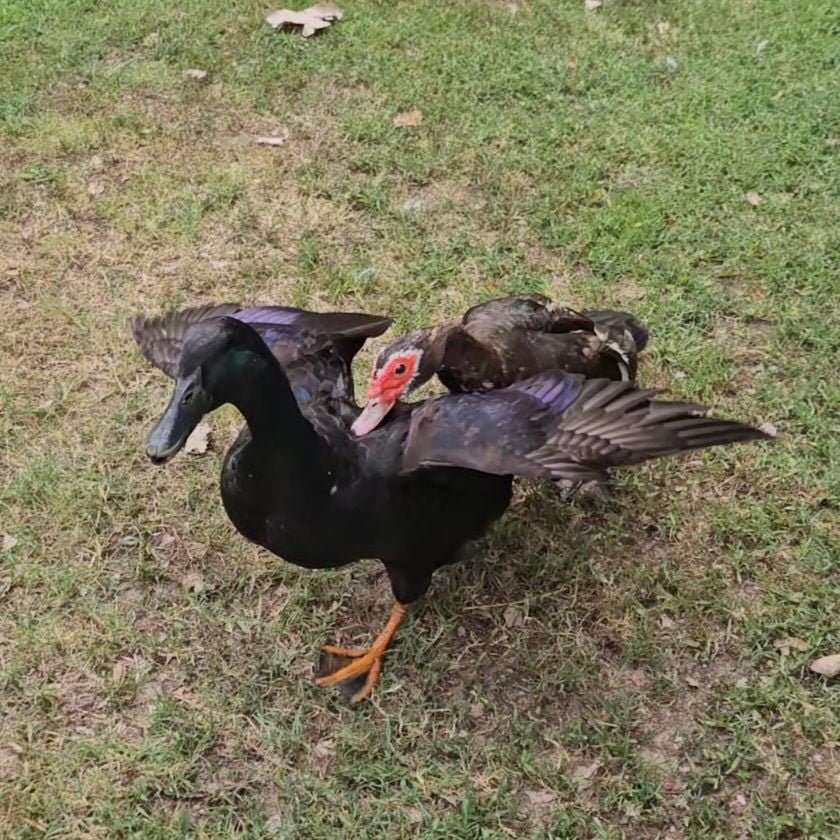
6. Behavioral Changes in Established Ducks
Sometimes, the introduction of new ducks can cause behavioral changes in your established flock, such as increased aggression, stress, or even a drop in egg production.
- Problem: Increased Aggression or Stress
- Solution: Sudden behavioral changes can be a sign that the introduction process is moving too quickly. Slow down the process, allowing the ducks more time to adjust to the new flock members. Provide additional enrichment activities to reduce stress and give the ducks something positive to focus on, such as new foraging opportunities or interactive toys.
- Problem: Decline in Egg Production
- Solution: Stress from the introduction process can lead to a temporary drop in egg production. Ensure that the ducks have a quiet, safe environment with ample nesting space and minimal disturbances. If the issue persists, evaluate the flock’s overall health and consider consulting a veterinarian to rule out any underlying health concerns.
7. Reintroducing Ducks After Separation
If a duck has been temporarily separated due to illness, injury, or aggression, reintroducing them to the flock can be challenging.
- Problem: Difficulty in Reintegrating
- Solution: Reintroduce the separated duck gradually, starting with visual contact and then moving to supervised physical interactions. Treat the process as you would when introducing a new duck, with patience and careful observation. If the flock struggles to accept the reintroduced duck, consider using a buddy system, pairing the duck with a friendly flock member during the reintroduction process.
Final Thoughts on Common Challenges and Solutions
Successfully integrating new ducks into an existing flock requires patience, careful observation, and a proactive approach to problem-solving. By anticipating common challenges and implementing these solutions, you can help ensure a smoother transition and maintain a peaceful, happy flock. Remember, every flock is unique, and what works for one group may need to be adjusted for another. Stay flexible, and be prepared to try different strategies until you find what works best for your ducks.
Final Thoughts: Fostering Harmony and Building a Strong Flock
Introducing new ducks to your flock is an exciting process that requires careful planning, patience, and attentiveness. The journey from separation to full integration can be challenging, but the rewards of a cohesive, happy flock are well worth the effort. Here’s a deeper look at what to keep in mind as you navigate this important phase:
Patience is Key
Integration is a gradual process, and each flock will adapt at its own pace. Ducks are sensitive to changes in their social environment, and the introduction of new members can disrupt their established routines. Patience is crucial during this time. Allow your ducks to acclimate to the changes at their own speed and avoid rushing the process. The goal is to create a smooth transition that minimizes stress and fosters positive relationships.
- Take it Slow: Begin with a controlled introduction and gradually increase the time the new ducks spend with the existing flock. Rushing the process can lead to increased aggression and stress. By taking it slow, you give all ducks the opportunity to adjust and establish new social dynamics in a more natural and less disruptive manner.
- Observe Regularly: Keep a close eye on the interactions between new and existing ducks. Look for signs of stress, aggression, or acceptance. Regular observations will help you identify and address any issues early on, ensuring that the integration process remains on track.
Monitor Interactions Closely
Careful observation of your ducks’ behavior is essential for a successful integration. Watch how the new ducks interact with the established flock and how the existing ducks respond to the newcomers.
- Look for Positive Signs: Signs of acceptance include relaxed body language, shared foraging, and social behaviors like preening. These indicators suggest that the new ducks are beginning to fit in with the flock.
- Address Issues Promptly: If you notice any aggressive behavior, bullying, or signs of distress, intervene promptly. Whether it’s adjusting the environment, providing additional resources, or temporarily separating aggressive individuals, addressing issues quickly can prevent them from escalating and help maintain a peaceful flock dynamic.
Step In When Necessary
There may be times when the integration process doesn’t go as smoothly as hoped. Don’t hesitate to step in and take corrective actions if you observe persistent issues. Your proactive involvement can make a significant difference in achieving a harmonious flock.
- Implement Solutions: If conflicts arise, use the strategies outlined in the “Common Challenges and Solutions” section to address them. Whether it’s adjusting feeding stations, providing additional nesting spaces, or temporarily separating individuals, applying the right solutions can help resolve problems and facilitate a smoother integration.
- Seek Expert Advice: If you encounter persistent difficulties or unusual behaviors, consider seeking advice from a veterinarian or an experienced duck keeper. They can provide valuable insights and guidance tailored to your specific situation.
Enjoy the Rewards
Once the new ducks are fully integrated, you’ll reap the rewards of a harmonious and happy flock. A well-integrated flock will engage in positive social behaviors, enjoy shared activities, and thrive in a stable environment.
- Fostering a Joyful Environment: A cohesive flock will swim, forage, and interact together, creating a vibrant and enjoyable atmosphere. Watching your ducks grow comfortable with one another and develop strong bonds can be incredibly rewarding.
- Celebrate the Success: Take pride in the successful integration of your new ducks. Celebrate the achievement by continuing to provide excellent care and enrichment for your flock. Your dedication and effort will contribute to a thriving and joyful group of ducks.
Introducing new ducks to your flock is a process that involves careful planning, patience, and attentiveness. By taking the time to ensure a smooth transition, monitoring interactions closely, and stepping in when necessary, you set the stage for a peaceful and harmonious flock. With the right approach, your ducks will soon be swimming, foraging, and quacking together in harmony, creating a vibrant and joyful community that reflects your dedication and care.

Remember, every flock is unique, and the integration process may vary depending on individual personalities and dynamics. Embrace the journey, stay observant, and cherish the moments as your ducks come together to form a unified and happy group.
Other Posts you may enjoy
➡️ Pet Ducks: How Many should I have? And where do I get them from?
➡️ How To Get A Duck to Trust You?
➡️ How to Conduct a Duck Health Check: A Comprehensive Guide
➡️ The Ultimate Guide to Healthy Duck Snacks: Treats Your Ducks Will Love

